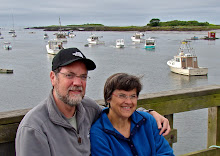 Rev. Spiwo Xapile, with his wife and daughter, in Malungeni on Nov. 15
Rev. Spiwo Xapile, with his wife and daughter, in Malungeni on Nov. 15 The interior of the sanctuary of the Malungeni Presbyterian Church
The interior of the sanctuary of the Malungeni Presbyterian Church The South African pastors and elders with Tom Forster-Smith, Malungeni, Nov. 15
The South African pastors and elders with Tom Forster-Smith, Malungeni, Nov. 15It started off with a meal of 16 sheep slaughtered especially for the occasion. VIP guests (like me) had to eat plates of sheep's liver and other organs, like hearts and kidneys. I managed a few bites, and then, as my stomach churned, I quickly headed for outdoors, where traditional Xhosa dancers led the procession down the dirt road to the church building.
 Appetizing, isn't it?!
Appetizing, isn't it?! Xhosa dancers
Xhosa dancers
At the church the moderator of the Uniting Presbyterian Church in Southern Africa, Rev. Makandawire from Zambia, unveiled the cornerstone with the church's name and the House of Hope's name inscribed on it.

Then we entered the sanctuary and for the next 4 hours heard numerous ministers preaching and giving greetings and making remarks, accompanied by a lot of congregational singing and dancing. There is no such thing as a "frozen chosen" Presbyterian in Malungeni, South Africa... every hymn is accompanied by lots of dancing and rhythmic moving.


Even the children hung in there for four hours, though most of them sat outside the sanctuary in the overflow seating area for the occasion. These are the next generation of Presbyterians in Malungeni, for whom we have helped to build a church. Thanks for your support for this project of international mission partnership that has been such a focus of our efforts over the past five years. As you can see, your support has been well worth the effort!










